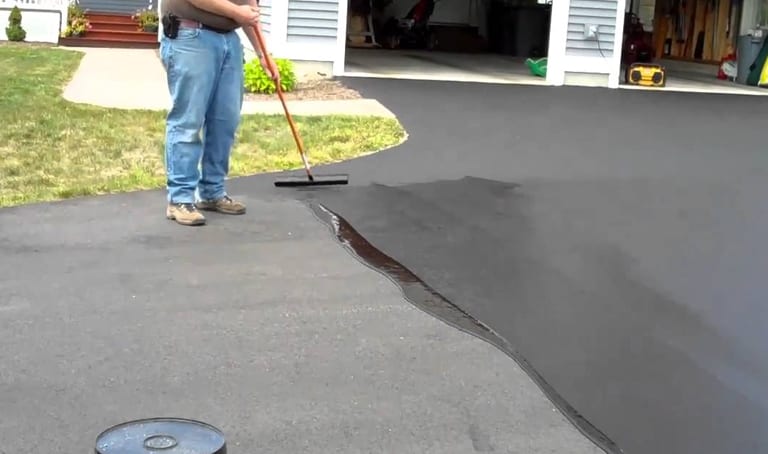Elevate Safety and Appeal: Angled Parking Lot Solutions with Asphalt Sealing
Warm Mix Asphalt: A Sustainable Option for Sidewalk
Hot Mix Asphalt (HMA) has emerged as a leading lasting selection for pavement solutions, providing a myriad of ecological advantages and cutting-edge innovations. As the need for environment-friendly building and construction techniques expands, discovering the subtleties of HMA's sustainability can supply important understandings right into the future of sidewalk services.
Ecological Benefits of Hot Mix Asphalt

Additionally, Hot Mix Asphalt aids to minimize urban warm island results. Its dark color absorbs sunlight, lowering the amount of warm reflected back right into the environment compared to lighter-colored sidewalks. This can decrease ambient temperature levels in city locations, lowering the need for cooling and inevitably minimizing power usage.
On top of that, Warm Mix Asphalt adds to improved stormwater monitoring. Its porous nature allows water to infiltrate the pavement and charge groundwater supplies, reducing overflow and the danger of flooding. These environmental advantages make Warm Mix Asphalt a sustainable selection for leading freeways and roads.
Energy Effectiveness in HMA Production
Is power efficiency a vital aspect in the production of Hot Mix Asphalt (HMA)? Power plays a significant duty in the manufacturing of HMA, affecting both price and environmental sustainability. One crucial facet of power performance in HMA production is the use of warm mix asphalt (WMA) innovations.
In addition, developments in plant technologies have actually led to more energy-efficient HMA manufacturing processes. By maximizing power use in HMA production, the industry can minimize its carbon impact while preserving high-quality sidewalk materials.
Recyclability of Warm Mix Asphalt
The recyclability of Hot Mix Asphalt (HMA) is an essential element of its sustainability and long-term environmental impact. HMA is just one of one of the most recycled products in the United States, with over 100 million lots of redeemed asphalt pavement (RAP) being recycled yearly in new sidewalk construction. Recycling HMA offers several ecological advantages, such as lowering the need for virgin materials, lowering power usage throughout production, and reducing the amount of waste sent out to garbage dumps.
The procedure of reusing HMA includes grating the existing sidewalk, squashing it into smaller pieces, and blending it with new aggregate and asphalt binder to create a recycled mix. This recycled mix can usually carry out as well as or perhaps far better than standard HMA, while requiring less resources and creating lower moved here greenhouse gas emissions. By including RAP into new sidewalk tasks, road agencies can preserve natural deposits, reduce prices, and reduce the ecological footprint of roadway construction and upkeep activities. On the whole, the recyclability of HMA plays a considerable role in advertising lasting techniques within the sidewalk sector.

Long-Term Performance of HMA
Asphalt sidewalks demonstrate durability and resilience over an extended duration, reflecting the lasting performance of Warm Mix Asphalt (HMA) The durability of HMA can be connected to its ability to withstand rush hour lots, harsh weather, and the results of aging. Studies have revealed that well-designed and properly created HMA pavements can last for 20 years or i was reading this more with normal maintenance. The secret to making the most of the long-term efficiency of HMA lies in using top quality products, adhering to finest techniques in building and construction, and carrying out reliable maintenance methods. Correct drainage, routine evaluations, and timely repair services are essential for preserving the structural integrity of HMA pavements with time. Furthermore, advancements in HMA modern technology, such as the usage of polymer-modified binders and warm mix asphalt, have actually better boosted the durability and durability of HMA sidewalks. By focusing on high quality building and construction and upkeep techniques, HMA proceeds to verify itself as a affordable and sustainable solution for lasting pavement facilities.

HMA: Toughness and Sustainability
Showing both longevity and sustainability, Hot Mix Asphalt (HMA) has come to be a keystone in the construction of long-lasting pavement facilities - regrading. HMA's longevity originates from its capacity to endure hefty loads, extreme weather, and high traffic Read Full Report volumes, making it a reliable option for roads, freeways, and flight terminal runways. The structure of HMA, which generally consists of aggregates, binder, and filler, plays an important role in enhancing its long life and resistance to tear and wear
Additionally, HMA's sustainability hinges on its recyclability and energy-efficient manufacturing procedure. The capacity to recycle reclaimed asphalt pavement (RAP) in new HMA combinations lowers the demand for virgin materials and minimizes the ecological effect of sidewalk building and construction and maintenance. Additionally, the power efficiency of generating HMA depends on its reduced mixing temperature levels compared to various other sidewalk products, leading to lowered energy usage and greenhouse gas exhausts.
Conclusion
To conclude, warm mix asphalt (HMA) provides a sustainable service for pavement with its eco pleasant attributes. HMA's recyclability, power effectiveness in manufacturing, and long-term sturdiness make it a green option for roadway construction. By saving all-natural sources, minimizing waste, and decreasing greenhouse gas emissions, HMA plays a crucial duty in advertising sustainability in infrastructure development. Its capability to alleviate metropolitan heat island results better underscores its importance in producing resilient and environmentally mindful pavement systems.
HMA is one of the most recycled products in the United States, with over 100 million heaps of redeemed asphalt sidewalk (RAP) being recycled every year in new pavement building.The process of recycling HMA includes milling the existing sidewalk, crushing it right into smaller pieces, and mixing it with brand-new accumulation and asphalt binder to produce a recycled mix.Asphalt pavements demonstrate sturdiness and strength over an extensive duration, reflecting the lasting performance of Warm Mix Asphalt (HMA) In addition, advancements in HMA innovation, such as the usage of polymer-modified binders and cozy mix asphalt, have even more boosted the toughness and longevity of HMA pavements. The ability to reuse recovered asphalt sidewalk (RAP) in new HMA mixtures decreases the demand for virgin materials and minimizes the ecological impact of pavement building and construction and maintenance.